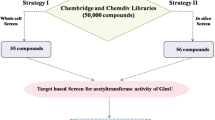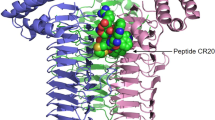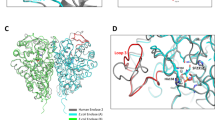Abstract
The dynamic, intracellular, O-GlcNAc modification is of continuing interest and one whose study through targeted “chemical genetics” approaches is set to increase. Of particular importance is the inhibition of the O-GlcNAc hydrolase, O-GlcNAcase (OGA), since this provides a route to elevate cellular O-GlcNAc levels, and subsequent phenotypic evaluation. Such a small molecule approach complements other methods and potentially avoids changes in protein–protein interactions that manifest themselves in molecular biological approaches to O-GlcNAc transferase knockout or over-expression. Here we describe the kinetic, thermodynamic and three-dimensional structural analysis of a bacterial OGA analogue from Bacteroides thetaiotaomicron, BtGH84, in complex with a lactone oxime (LOGNAc) and a lactam form of N-acetylglucosamine and compare their binding signatures with that of the more potent inhibitor O-(2-acetamido-2-deoxy-d-glucopyranosylidene)amino N-phenyl carbamate (PUGNAc). We show that both LOGNAc and the N-acetyl gluconolactam are significantly poorer inhibitors than PUGNAc, which may reflect poorer mimicry of transition state geometry and steric clashes with the enzyme upon binding; drawbacks that the phenyl carbamate adornment of PUGNAc helps mitigate. Implications for the design of future generations of inhibitors are discussed.





Similar content being viewed by others
References
Aguilar-Moncayo M, Gloster TM, Turkenburg JP, García-Moreno MI, Ortiz Mellet C, Davies GJ, Fernádez G (2009) Glycosidase inhibition by ring-modified castanospermine analogues: tackling enzyme selectivity by inhibitor tailoring. Org Biomol Chem 7:2738–2747
Akimoto Y, Hart GW, Wells L, Vosseller K, Yamamoto K, Munetomo E, Ohara-Imaizumi M, Nishiwaki C, Nagamatsu S, Hirano H et al (2007) Elevation of the post-translational modification of proteins by O-linked N-acetylglucosamine leads to deterioration of the glucose-stimulated insulin secretion in the pancreas of diabetic Goto-Kakizaki rats. Glycobiology 17:127–140
Arias EB, Kim J, Cartee GD (2004) Prolonged incubation in PUGNAc results in increased protein O-linked glycosylation and insulin resistance in rat skeletal muscle. Diabetes 53:921–930
Balcewich MD, Stubbs KA, He Y, James TW, Davies GJ, Vocadlo DJ, Mark BL (2009) Insight into a strategy for attenuating AmpC-mediated β-lactam resistance: structural basis for selective inhibition of the glycoside hydrolase NagZ. Prot Sci 18:1541–1551
Beer D, Vasella A (1985) Aldonhydroximo-lactones—preparation and determination of configuration. Helv Chim Acta 68:2254–2274
Beer D, Vasella A (1986) Inhibition of emulsion by d-gluconhydroximo-1,5-lactone and related compounds. Helv Chim Acta 69:267–270
Beer D, Maloisel JL, Rast DM, Vasella A (1990) Synthesis of 2-acetamido-2-deoxy-d-gluconhydroximolactone-derived and chitobionhydroximolactone-derived N-phenylcarbamates, potential inhibitors of beta-N-acetylglucosaminidase. Helv Chim Acta 73:1918–1922
Butkinaree C, Park K, Hart GW (2010) O-linked beta-N-acetylglucosamine (O-GlcNAc): extensive crosstalk with phosphorylation to regulate signaling and transcription in response to nutrients and stress. Biochim Biophys Acta 1800:96–106
Cantarel BL, Coutinho PM, Rancurel C, Bernard T, Lombard V, Henrissat B (2009) The Carbohydrate-Active EnZymes database (CAZy): an expert resource for glycogenomics. Nucleic Acids Res 37:D233–D238
Chou TY, Hart GW (2001) O-linked N-acetylglucosamine and cancer: messages from the glycosylation of c-Myc. Adv Exp Med Biol 491:413–418
Collaborative Computational Project Number 4 (1994) The CCP4 suite: programs for protein crystallography. Acta Crystallogr D50:760–763
Combes CL, Birch GG (1988) Interaction of d-glucono-1,5-lactone with water. Food Chem 27:283–298
Conchie J, Levvy GA (1957) Inhibition of glycosidases by aldonolactones of corresponding configuration. Biochem J 65:389–395
Davies GJ, Martinez-Fleites C (2010) The O-GlcNAc modification: 3-D structure, enzymology and the development of selective inhibitors to probe disease. Biochem Soc Trans (in press)
Davies GJ, Wilson KS, Henrissat B (1997) Nomenclature for sugar-binding subsites in glycosyl hydrolases. Biochem J 321:557–559
Dennis RJ, Taylor EJ, Macauley MS, Stubbs KA, Turkenburg JP, Hart SJ, Black GN, Vocadlo DJ, Davies GJ (2006) Structure and mechanism of a bacterial beta-glucosaminidase having O-GlcNAcase activity. Nat Struct Mol Biol 13:365–371
Dias WB, Hart GW (2007) O-GlcNAc modification in diabetes and Alzheimer’s disease. Mol Biosyst 3:766–772
Donadio AC, Lobo C, Tosina M, de la Rosa V, Martin-Rufian M, Campos-Sandoval JA, Mates JM, Marquez J, Alonso FJ, Segura JA (2008) Antisense glutaminase inhibition modifies the O-GlcNAc pattern and flux through the hexosamine pathway in breast cancer cells. J Cell Biochem 103:800–811
Dong DL, Hart GW (1994) Purification and characterization of an O-GlcNAc selective N-acetyl-beta-d-glucosaminidase from rat spleen cytosol. J Biol Chem 269:19321–19330
Dorfmueller HC, Borodkin VS, Schimpl M, Shepherd SM, Shpiro NA, van Aalten DM (2006) GlcNAcstatin: a picomolar, selective O-GlcNAcase inhibitor that modulates intracellular O-glcNAcylation levels. J Am Chem Soc 128:16484–16485
Dorfmueller HC, Borodkin VS, Schimpl M, van Aalten DM (2009) GlcNAcstatins are nanomolar inhibitors of human O-GlcNAcase inducing cellular hyper-O-GlcNAcylation. Biochem J 420:221–227
Emsley P, Cowtan K (2004) Coot: model-building tools for molecular graphics. Acta Crystallogr D60:2126–2132
Fleet GWJ, Carpenter NM, Petursson S, Ramsden NG (1990) Synthesis of deoxynojirimycin and of nojirimycin delta-lactam. Tetrahedron Lett 31:409–412
Gao Y, Wells L, Comer FI, Parker GJ, Hart GW (2001) Dynamic O-glycosylation of nuclear and cytosolic proteins: cloning and characterization of a neutral, cytosolic beta-N-acetylglucosaminidase from human brain. J Biol Chem 276:9838–9845
Gloster TM, Davies GJ (2010) Glycosidase inhibition: assessing mimicry of the transition state. Org Biomol Chem 8:305–320
Gloster TM, Meloncelli P, Stick R, Zechel D, Vasella A, Davies GJ (2007) Glycosidase inhibition: an assessment of the binding of eighteen putative transition-state mimics. J Am Chem Soc 129:2345–2354
Granier T, Vasella A (1998) Synthesis and some transformations of 2-acetamido-5-amino-3,4,6-tri-O-benzyl-2,5-dideoxy-d-glucono-1, 5-lactam. Helv Chim Acta 81:865–880
Griffith LS, Schmitz B (1995) O-linked N-acetylglucosamine is upregulated in Alzheimer brains. Biochem Biophys Res Commun 213:424–431
Hart GW, Housley MP, Slawson C (2007) Cycling of O-linked beta-N-acetylglucosamine on nucleocytoplasmic proteins. Nature 446:1017–1022
He Y, Martinez-Fleites C, Bubb A, Gloster TM, Davies GJ (2009) Structural insight into the mechanism of streptozotocin inhibition of O-GlcNAcase. Carbohydr Res 344:627–631
He Y, Macauley MS, Stubbs KA, Vocadlo DJ, Davies GJ (2010) Visualizing the reaction coordinate of an O-GlcNAc hydrolase. J Am Chem Soc 132:1807–1809
Heightman TD, Vasella AT (1999) Recent insights into inhibition, structure, and mechanism of configuration-retaining glycosidases. Angew Chem Int Ed 38:750–770
Hoos R, Naughton AB, Thiel W, Vasella A, Weber W, Rupitz K, Withers SG (1993) d-Gluconhydroximo-1, 5-lactam and related N-arylcarbamates—theoretical calculations, structure, synthesis, and inhibitory effect on beta-glucosidases. Helv Chim Acta 76:2666–2686
Horsch M, Hoesch L, Vasella A, Rast DM (1991) N-acetylglucosaminono-1,5-lactone oxime and the corresponding (phenylcarbamoyl)oxime novel and potent inhibitors of beta-N-acetylglucosaminidase. Eur J Biochem 197:815–818
Hrmova M, de Gori R, Smith BJ, Vasella A, Vargese JN, Fincher GB (2004) Three-dimensional structure of the barley β-d-glucan glucohydrolase in complex with a transition state mimic. J Biol Chem 279:4970–4980
Hrmova M, Streltsov VA, Smith BJ, Vasella A, Vargese JN, Fincher GB (2005) Structural rationale for low-nanomolar binding of transition state mimics to a family GH3 β-d-glucan glucohydrolase from barley. Biochemistry 44:16529–16539
Hurtado-Guerrero R, Dorfmueller HC, van Aalten DM (2008) Molecular mechanisms of O-GlcNAcylation. Curr Opin Struct Biol 18:551–557
Inouye S, Tsuruoka T, Ito T, Niida T (1968) Structure and synthesis of nojirimycin. Tetrahedron 24:2125
Knight ZA, Shokat KM (2005) Features of selective kinase inhibitors. Chem Biol 12:621–637
Kreppel LK, Hart GW (1999) Regulation of a cytosolic and nuclear O-GlcNAc transferase. Role of the tetratricopeptide repeats. J Biol Chem 274:32015–32022
Kroncke KD, Fehsel K, Sommer A, Rodriguez ML, Kolb-Bachofen V (1995) Nitric oxide generation during cellular metabolization of the diabetogenic N-methyl-N-nitroso-urea streptozotozin contributes to islet cell DNA damage. Biol Chem Hoppe Seyler 376:179–185
Lalegerie P, Legler G, Yon JM (1982) The use of inhibitors in the study of glycosidases. Biochimie 64:977–1000
Leaback DH (1968) On the inhibition of beta-N-acetyl-d-glucosaminidase by 2-acetamido-2-deoxy-d-glucono-(1,5)-lactone. Biochem Biophys Res Commun 32:1025–1030
Lefebvre T, Dehennaut V, Guinez C, Olivier S, Drougat L, Mir A-M, Mortuaire M, Vercoutter-Edouart A-S, Michalski J-C (2010) Dysregulation of the nutrient/stress sensor O-GlcNAcylation is involved in the etiology of cardiovascular disorders, type-2 diabetes and Alzheimer’s disease. Biochim Biophys Acta 1800:67–79
Liu F, Iqbal K, Grundke-Iqbal I, Hart GW, Gong CX (2004) O-GlcNAcylation regulates phosphorylation of tau: a mechanism involved in Alzheimer’s disease. Proc Natl Acad Sci USA 101:10804–10809
Lubas WA, Hanover JA (2000) Functional expression of O-linked GlcNAc transferase. Domain structure and substrate specificity. J Biol Chem 275:10983–10988
Macauley MS, Vocadlo DJ (2010) Increasing O-GlcNAc levels: an overview of small-molecule inhibitors of O-GlcNAcase. Biochim Biophys Acta 1800:107–121
Macauley MS, Whitworth GE, Debowski AW, Chin D, Vocadlo DJ (2005) O-GlcNAcase uses substrate-assisted catalysis: kinetic analysis and development of highly selective mechanism-inspired inhibitors. J Biol Chem 280:25313–25322
Macauley MS, Bubb AK, Martinez-Fleites C, Davies GJ, Vocadlo DJ (2008) Elevation of global O-GlcNAc levels in 3T3-L1 adipocytes by selective inhibition of O-GlcNAcase does not induce insulin resistance. J Biol Chem 283:34687–34695
Manning G, Whyte DB, Martinez R, Hunter T, Sudarsanam S (2002) The protein kinase complement of the human genome. Science 298:1912–1934
Marcelo F, He Y, Yuzwa SA, Nieto L, Jiménez-Barbero J, Sollogoub M, Vocadlo DJ, Davies GJ, Blériot Y (2009) Molecular basis for inhibition of GH84 glycoside hydrolases by substituted azepanes: conformational flexibility enables probing of substrate distortion. J Am Chem Soc 131:5390–5392
Martinez-Fleites C, He Y, Davies GJ (2010) Structural analyses of enzymes involved in the O-GlcNAc modification. Biochim Biophys Acta 1800:122–133
McClain DA, Lubas WA, Cooksey RC, Hazel M, Parker GJ, Love DC, Hanover JA (2002) Altered glycan-dependent signaling induces insulin resistance and hyperleptinemia. Proc Natl Acad Sci USA 99:10695–10699
Miller DJ, Gong X, Shur BD (1993) Sperm require beta-N-acetylglucosaminidase to penetrate through the egg zona pellucida. Development 118:1279–1289
Mohan H, Vasella A (2000) An improved synthesis of 2-acetamido-2-deoxy-d-gluconohydroximolactone (PUGNAc), a strong inhibitor of beta-N-acetylglucosaminidases. Helv Chim Acta 83:114–118
Nishimura Y, Adachi H, Satoh T, Shitara E, Nakamura H, Kojima F, Takeuchi T (2000) All eight stereoisomeric d-glyconic-delta-lactams: synthesis, conformational analysis, and evaluation as glycosidase inhibitors. J Org Chem 65:4871–4882
Olszewski NE, West CM, Sassi SO, Hartweck LM (2010) O-GlcNAc protein modification in plants: evolution and function. Biochim Biophys Acta 1800:49–56
Overkleeft HS, Vanwiltenburg J, Pandit UK (1993) An expedient stereoselective synthesis of gluconolactam. Tetrahedron Lett 34:2527–2528
Papageorgiou AC, Oikonomakos NG, Leonidas DD, Bernet B, Beer D, Vasella A (1991) The binding of d-gluconohydroximo-1,5-lactone to glycogen-phosphorylase—kinetic, ultracentrifugation and crystallographic studies. Biochem J 274:329–338
Pathak S, Dorfmueller HC, Borodkin VS, van Aalten DM (2008) Chemical dissection of the link between streptozotocin, O-GlcNAc, and pancreatic cell death. Chem Biol 15:799–807
Pauling L (1946) Molecular architecture and biological reactions. Chem Eng News 24:1375–1377
Rao FV, Dorfmueller HC, Villa F, Allwood M, Eggleston IM, van Aalten DM (2006) Structural insights into the mechanism and inhibition of eukaryotic O-GlcNAc hydrolysis. EMBO J 25:1569–1578
Reese ET, Parrish FW, Ettlinger M (1971) Nojirimycin and d-glucono-1,5-lactone as inhibitors of carbohydrases. Carbohydr Res 18:381–388
Scaffidi A, Stubbs KA, Dennis RJ, Taylor EJ, Davies GJ, Vocadlo DJ, Stick RV (2007) A 1-acetamido derivative of 6-epivalienamine: an inhibitor of a diverse array of β-N-acetylglucosaminidases. Org Biomol Chem 5:3013–3019
Shanmugasundaram B, Debowski AW, Dennis RJ, Davies GJ, Vocadlo DJ, Vasella A (2006) Inhibition of O-GlcNAcase by a gluco-configured nagstatin and a PUGNAc–imidazole hybrid inhibitor. Chem Commun 4372–4374
Stubbs KA, Zhang N, Vocadlo DJ (2006) A divergent synthesis of 2-acyl derivatives of PUGNAc yields selective inhibitors of O-GlcNAcase. Org Biomol Chem 4:839–845
Tailford LN, Offen WA, Smith NL, Dumon C, Morland C, Gratien J, Heck M-P, Stick RV, Blériot Y, Vasella A et al (2008) Structural and biochemical evidence for a boat-like transition state in β-mannosidases. Nat Chem Biol 4:306–312
Torres CR, Hart GW (1984) Topography and polypeptide distribution of terminal N-acetylglucosamine residues on the surfaces of intact lymphocytes. Evidence for O-linked GlcNAc. J Biol Chem 259:3308–3317
Vasella A, Davies G, Böhm M (2002) Glycosidase mechanisms. Curr Opin Chem Biol 6:619–629
Vocadlo D, Davies GJ (2008) Mechanistic insights into glycosidase chemistry. Curr Opin Chem Biol 12:539–555
Vosseller K, Wells L, Lane MD, Hart GW (2002) Elevated nucleocytoplasmic glycosylation by O-GlcNAc results in insulin resistance associated with defects in Akt activation in 3T3-L1 adipocytes. Proc Natl Acad Sci USA 99:5313–5318
Wells L, Vosseller K, Hart GW (2001) Glycosylation of nucleocytoplasmic proteins: signal transduction and O-GlcNAc. Science 291:2376–2378
Winn MD, Isupov MN, Murshudov GN (2001) Use of TLS parameters to model anisotropic displacements in macromolecular refinement. Acta Crystallogr D 57:122–133
Yamamoto H, Uchigata Y, Okamoto H (1981) Streptozotocin and alloxan induce DNA strand breaks and poly(ADP-ribose) synthetase in pancreatic islets. Nature 294:284–286
Yao PJ, Coleman PD (1998) Reduction of O-linked N-acetylglucosamine-modified assembly protein-3 in Alzheimer’s disease. J Neurosci 18:2399–2411
Yuzwa SA, Macauley MS, Heinonen JE, Shan X, Dennis RJ, He Y, Whitworth GE, Stubbs KA, McEachern EJ, Davies GJ et al (2008) A potent mechanism-inspired O-GlcNAcase inhibitor that blocks phosphorylation of tau in vivo. Nat Chem Biol 4:483–490
Zou L, Yang S, Hu S, Chaudry IH, Marchase RB, Chatham JC (2007) The protective effects of PUGNAc on cardiac function after trauma-hemorrhage are mediated via increased protein O-GlcNAc levels. Shock 27:402–408
Acknowledgments
The authors thank the Biotechnology and Biological Sciences Research Council for their funding. G. J. D. is a Royal Society Wolfson Research Merit Award recipient. Y. H. was partially supported by the Wild Fund of the Department of Chemistry at York. T. M. G. is a Sir Henry Wellcome Postdoctoral Fellow, funded by the Wellcome Trust. Professor Andrea Vasella (ETH Zürich) is thanked for provision of N-acetyl gluconolactam 3.
Author information
Authors and Affiliations
Corresponding authors
Rights and permissions
About this article
Cite this article
He, Y., Bubb, A.K., Stubbs, K.A. et al. Inhibition of a bacterial O-GlcNAcase homologue by lactone and lactam derivatives: structural, kinetic and thermodynamic analyses. Amino Acids 40, 829–839 (2011). https://doi.org/10.1007/s00726-010-0700-6
Received:
Accepted:
Published:
Issue Date:
DOI: https://doi.org/10.1007/s00726-010-0700-6




